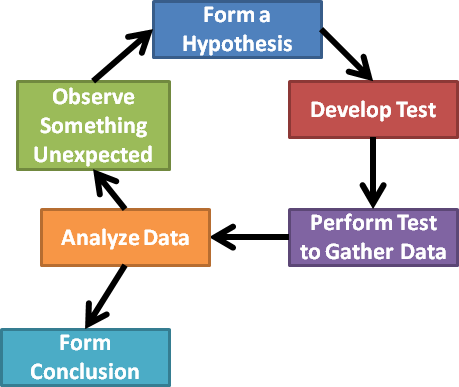Scientific Method
The Scientific Method is the process by which answers are determined using observation and experimentation. This process is iterative, meaning that it repeats itself over and over again. The more you observe, the more new information you process and then the more experiments you run. If you don't really come to a conclusion and keep repeating the process over and over, the Scientific Method actually becomes less of an iterative process and really more of a spiral.
Maybe that's why some scientists appear to spiral into madness.
Regardless of the mental status of the employees at CERN, the Scientific Method follows the process in the picture below.

Technically, since it's a loop, you can enter the Scientific Method anywhere. How you'd start by performing a test when you hadn't developed it yet is beyond me, but you never know, it could happen. Typically, you proceed by following the process below.
Observe Something Unexpected. This is usually the first step in solving a problem the scientific way. You have to notice a problem in order to solve it.
Form a Hypothesis. A hypothesis is an assumption about the conclusion. It's what you think is happening after you observe something. Strictly speaking, a hypothesis has to be testable. If you think that your observation is the result of magic, then it's not really a hypothesis because magic by its very nature is supernatural. Science is natural. Hypotheses are testable.
Develop a Test. This step is done in order to separate out all of the components of the phenomenon before actually proceeding to the testing phase. If you just jump into testing without planning for it, you have no way of determining what actually caused what you observed because there are multiple aspects to every event. This is sometimes referred to as identifying and isolating variables. Ideally, you need to design your test so that you only test one variable at a time. That way you can be sure that changes from each test are the result of changing one variable. This Test Development Phase is easily the most important. It's so important that there is a button in this Engineering Section called Test Planning that goes in depth about planning a test. 10/10 would recommend reading it.
Perform Test to Gather Data. Basically, run the test(s) that you developed in the previous step and collect the data from the test(s).
Analyze the Data. This step is the first time you have to put your High School and College math courses to use in Science. It's important that you take the data you collected during your test, use statistics to analyze your data and find trends. You need to see what, if any, conclusions can be drawn from what you observed. You need to apply what you know. Additionally, you need to have enough data points to be able to draw conclusions. While it may be boring to repeat the same steps over and over again, doing a test once (A.K.A. The Mythbusters Method) is not scientific. Maybe you made a mistake on that one test. Maybe there was a variable you didn't account for. Bottom line, you need to have enough data to analyze.
Observe Something Unexpected...again. It is at this point that the division between Engineers and Scientists is defined. Scientists often analyze the data and get distracted. They observe something unexpected again. Which is fine. It's also the more fun route as you get to do Science again!
Form Conclusion(s). The Engineer route is to take your Data Analysis and form conclusions. The conclusions about your data need to be demonstratable and repeatable. You should be able to look at the hypothesis, set up the test, run it, and get the same data as before. If you don't, then you cannot draw conclusions and you need to form a different hypothesis.
The next steps are up to you. Science is fun. After drawing conclusions, go the Scientist route and observe something unexpected again. Or, better yet, follow the engineering process to its conclusion. To learn about that, click on the Engineering 101 link up above.